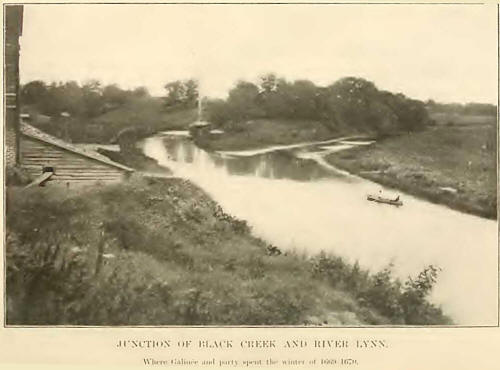|

The earliest mention we
have of the Lake Erie country is in the records of Father Daillon, of
whom there will be further mention made in Chapter XIV. Father Daillon
visited what is now South-western Ontario in 1626, and though it is
somewhat uncertain what district he is describing, it is probable he was
near the Lake Erie shore, for he speaks of the great number of wild fowl
in the marshes and along the streams. He also mentions the larger game,
for he says, “The deer, with which this country abounds, are easily
captured, for they have but little sense of fear, and the Indians drive
them into wedge-shaped inclosures. The streams abound in fish, and the
marshes in wild ducks and turkeys.”
Forty-four years later
we have reliable mention of Long Point in the journal of Galinee. For
this information the writer is indebted directly to Mr. J. H. Coyne,
M.A., of St. Thomas, who is preparing for the press the journal of
Galinde. Father Galinde and Father Dollier de Casson were two Sulpician
priests, who made a voyage of discovery through lakes Ontario, Erie and
Huron in the years 1669 and 1670, returning to Montreal via the Sault,
Lake Nipissing and the Ottawa river.
Galinee’s party,
consisting of the other priest and seven Frenchmen (nine in all),
reached Black Creek, where it joins the River Lynn (near the present
site of Port Dover), in October, 1669. There they encamped for the
winter. On the 23rd of March following, they went down to the lake shore
and planted a cross, with the Royal arms affixed, and a written
declaration that they had taken possession of it as unoccupied territory
in the name of King Louis XIV. On the 26th of March they proceeded from
the river mouth in three canoes. Off Turkey Point they were stopped by a
head wind and forced to land. One of their canoes being insecurely
beached was carried out into the bay and lost, and the cargo of the lost
canoe had to be divided between the other two. Four men took charge of
the canoes, and five, including the two priests, had to proceed west to
Kettle Creek by land. It seems that they marched from the Point about
two miles to the high bank, and then followed substantially the present
lake road through the location of Port Rowan to Big Creek, about where
is the present Port Royal. This stream they followed up for some
distance, but being dismayed at the widening swamp, walked down the east
bank to the mouth of the creek. There they built a raft and crossed
without accident. They went on to the portage, where their companions
joined them some days later. After celebrating Easter together they
again separated. On the shore near the present site of Port Stanley they
found the canoe Joliet had left the previous September on his return
from the exploration of the Mississippi. From there to Point Pelde they
travelled in canoes. At the latter point a storm wrecked one of the
canoes, and its cargo was entirely lost, including the altar service,
which they had intended to leave in a mission among the Potawatamies1
Thus they were obliged to give up the idea of the mission altogether,
and after making their way as far as Sault Ste. Marie they travelled
home by the ordinary route, namely, by the French and Ottawa rivers.
Galine speaks of the
Long Point country in glowing terms. He mentions the immense herds of
deer, which were to be seen feeding together. He admired the great
walnut trees, with their savory fruit, also the chestnuts, hickory nuts,
the wild grapes and apples, and says that it is a perfect paradise and
well suited for settlement.
In the journal of
Charlevoix, of the date June, 1721, there is mention of Long Point, a
sandy ridge of land which had to be portaged.
Thus it will be seen
that though the country had been explored and commended by French
discoverers, it was destined to remain for more than a century without
settlement, until a strong and sturdy band of Loyalists should rear for
themselves new homes among the forests.
[The Potawatamies (or
Pouteouatamis) have a village near Detroit of one hundred and eighty
men. They bear for device the golden Carp, the Frog, the Crab, and the
Tortoise. They also compose the Village of St. Joseph, south of Lake
Michigan, to the number of one hundred warriors. (Report of M. de
Joncaire, “Documentary History of New York,” Vol. I., p. 25.)] |
